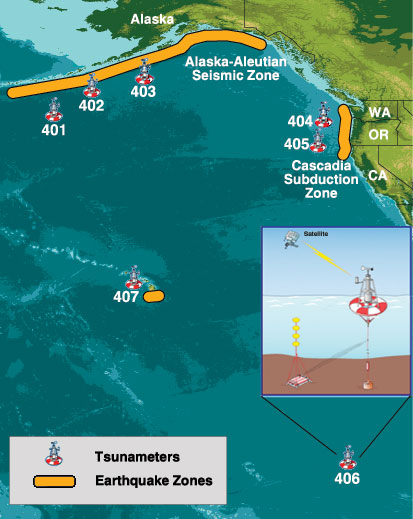DART System - Background (original) (raw)
 |
|---|
| Tsunameter Network |
As part of the U.S. National Tsunami Hazard Mitigation Program (NTHMP), deep-ocean tsunameters have been developed for the early detection, measurement, and real-time reporting of tsunamis in the open ocean. Tsunameters were developed by Project DART® (Deep-ocean Assessment and Reporting of Tsunamis) at NOAA's Pacific Marine Environmental Laboratory (PMEL). These systems have been strategically deployed near regions with a history of tsunami generation, to ensure measurement of the waves as they propagate towards threatened U.S. coastal communities and to acquire data critical to real-time forecasts. Locations of the 6 tsunameters comprising the operational network are shown on the accompanying map.
The tsunameter technology and operational responsibility for the Pacific network were transitioned from PMEL to NOAA's National Data Buoy Center (NDBC). NDBC provides access to all real-time tsunameter data.
A prototype tsunami forecasting system package that combines tsunameter network measurements with state-of-the-art numerical modeling technology has been developed to provide site-specific predictions of tsunami impact on the coast. The first operational version of this forecast system package will be implemented this year at NOAA's two Tsunami Warning Centers (Pacific Tsunami Warning Center, PTWC and West Coast & Alaska Tsunami Warning Center, WC/ATWC) to help address two important goals of the NOAA-led National Tsunami Hazard Mitigation Program:
- Reduce the loss of life and property in U.S. coastal communities.
- Reduce false alarms and the resulting high economic cost of unnecessary evacuations, physical risk to the population during evacuation, as well as loss of public confidence in the confidence in the warning system.